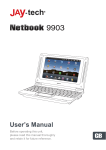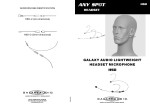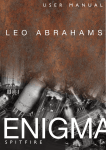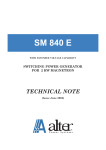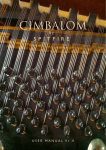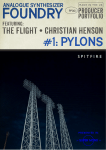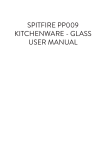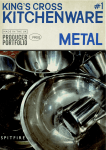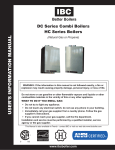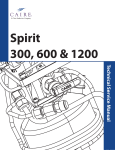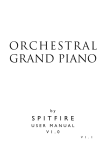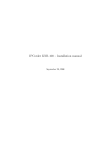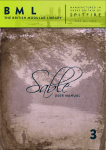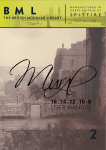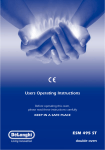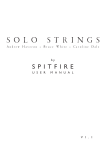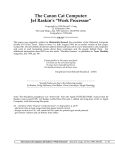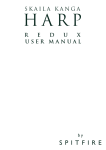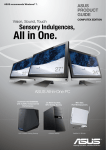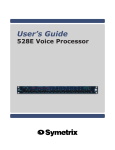Download general controls - Amazon Web Services
Transcript
Welcome. Thanks for being part of the Spitfire Audio project. We’ve tried to make this as brief and interesting as possible but we also understand that reading manuals is a bore, so stick this next to your loo and give it a read whenever you can. About Spitfire: Spitfire was formed in 2008 by a group of successful British composers as a means of producing the tools they needed for their busy work schedules. Sick of dry, humourless, ugly, unrealistic sounding libraries, Spitfire set about redefining the way samples were created. Our aim is to reproduce the conditions of top movie recording sessions and approach sampling as if we were recording a film score one note at a time. To record performances, and parts thereof, not scientifically created samples. To capture the timbre of a world-class set of players but also to record the room they were playing in. In 2013 Spitfire embraced their eclectic past as drum and bass heads, successful producers and programmers to produce a range of definitive instruments and tools recorded in smaller spaces, to provide tools for a wider variety of uses and users eager to experience the “Spitfire Way”. About Gwilym Simcock - Felt Piano Why be a Jack-of-all-trades when you can be a master of one? It is this sentiment and reason why we have searched high and low for the most sensitive, beautiful, sonorous, and honest piano sound. Perfect for those delicate ballads (think “Mad World” by Gary Jules) or that intimate, heart rendering cue (think Newman’s “American Beauty”). When carrying out sampling experiments some years ago we discovered the very beautiful world of an upright piano with a middle “practice felt” or “celeste” pedal engaged. Whilst being hard to get a decent sound out of it (it’s strange to play a piano loudly and have a muted soft sound come out), when it rang, boy did it produce the most beautifully unsophisticated, but gentle and touching sound. This became our “soft piano” available in return for a small donation to Unicef as part of our Labs range, which we have received many plaudits for. Christian Henson, on putting this library through it’s paces for some years now, went on a quest to find the perfect “celeste” pedal piano he could. His quest ended at Peregrine’s Pianos on the Grays Inn Road in London; purveyors of fine hand made uprights and grands. Spitfire built a room around this new piano in our HQ in Kings Cross a perfect environment to record instruments for our “Producer Portfolio” range - dedicated to providing producers, song writers and composers with raw, untreated instruments in a neutral space to make their own. This piano has been performed by Mercury Award nominee Gwilym Simcock and has been recorded by Joe Rubel and the Spitfire team with a number of rarefied microphones in a number of perspectives. From the almost vintage sound of a mono sound board mic, to a beautiful natural surround perspective of the room itself. Most celeste pedals allow for only one dynamic layer, but this piano is more responsive than others so not only did we record several round robins, we recorded 2 dynamic layers, release triggers and round robin pedal damping and releasing. We think it’s the most beautiful “soft” piano out there, this celeste pedal isn’t going to come off for a while!! PA G E 2 System Requirements KONTAKT - this library requires the full version of Kontakt to run, it will not work in the Kontakt ‘Player’: please make sure you have the absolute latest version of either Kontakt 4 or Kontakt 5. 98% of all enquiries to our support dept. are cured by the upgrade. This is a cutting edge library and it simply won’t work on anything but the latest versions. RECOMMENDED SPEC: The better your computer, the better the performance of Felt Piano. But not to worry if you’re not spec’d up to the hilt. All programs are provided with a set of parameters that enable you to tone back the CPU demands of any given patch. But moving forward, we’re confident this module will keep your computer busy for many years to come! We recommend a combination of high processor speeds, a good chunk of memory and a devoted 7200rpm eSata, USBII, Thunderbolt, or Firewire audio drive. The more memory you have, the less demand placed on your drive, and having a totally devoted drive gives you the chance to load less into memory and reduce load times. The higher the speed of your CPU, the more capable your computer will be to deal with some of the amazing, but complicated scripts we’ve written. PCs: We recommend an i5, or i7 Quad or 8 Core machine with 8 Gig or above memory. Vista 64 or Windows 7. However, it will work with SP2, Pentium or Athlon XP 1.4GHz 1Gig RAM. MACs: We recommend a Mac-Pro Intel Based Dual, Quad or 8 Core machine with 8 Gig or above memory. Mac OS 10.6.1 (Snow Leopard). However, we have made the module work satisfactorily on a Mac Mini 2.4 GHz and a MacBook Pro 2.4GHz Intel Core 2 Duo. DRIVES: Firewire, USBII, or eSata, 7200rpm. Ask your dealer for drives that are suitable for “AV use”. We always recommend as small a drive as possible, as the platter will be smaller and the seek time less. The library will eventually take up 25 Gig on your hard drive. If using several large libraries, or a number of Spitfire modules from the same machine, we really recommend having your samples distributed over a number of drives. Lacie eSata or Quadras 7200rpm we highly recommend. Moreover, an exciting development lies in the recent arrival of some amazing solid state (SSD) drives. With seek times reduced to a fraction (0.1ms vs 6-9ms) of what standard drives can offer, we are certain you will be able to reduce your sampler’s “pre-load” (page 24.) buffer tenfold meaning you’ll be able to load enormous orchestral palettes into a single machine. HOST: The Kontakt 4 platform should work comfortably on most commonly found platforms and DAWs. As always make sure you’re as up-to-date as you can afford! If you’re planning on building or adding Spitfire to an already large orchestral palette, we recommend running your library independently of your DAW, either on your host computer (e.g. via Re-Wire) or on a slave device (e.g.. via Midi or MOL). This will assist your load in times, and will allow your DAW to do what it does best, sort out all your note ons and note offs! PA G E 3 CONTENTS: INSTALLATION & GETTING STARTED 05 THE FRONT PANEL06 ARTICULATION STAVE & SIDE BAR 07 GENERAL CONTROLS08 MICROPHONE/ MIX SETTINGS09 THE PUNCH COG10 A COUPLE OF TROUBLESHOOTS11 INSTALLATION Because you’re reading this manual, we can presume you have successfully downloaded this product. Included in your download email are some detailed installation instructions, please follow these carefully before going any further. We’ll see you back here, when you’re installed! GETTING STARTED Before opening Kontakt please make sure you have THE LATEST VERSION OF KONTAKT 4.2.4 OR 5 INSTALLED. 95% of all service enquiries relating to spurious or strange behaviour of our wares are solved by installing the most recent version. As this is NOT a Kontakt Player Library YOU WILL NOT SEE THE MODULE IN THE “LIBRARY” PANE. Simply navigate to the product via the “FILE” browser pane. If you have never used Kontakt before we wholeheartedly recommend your familiarise yourself with the basics of patch (or instrument) loading, multi management, outputting and MIDI routing detailed in the Kontakt user-manual provided with your copy of Kontakt or in the “documentation” folder of your Kontakt file. PA G E 5 THE FRONT PANEL MIC/ MIX POSITIONS SIDE BAR GENERAL CONTROLS ARTICULATIONS PA G E 6 EXPRESSION CONTROLS ABOUT THE PATCHES We have produced 5 subtly different patches to suit differing tastes and applications. “Standard” - As we like it. “Medium Dynamics” - With the volume curve flattened slightly so the lower dynamic samples become hyperealised. “Flatter Dynamics” - Like above but with almost no volume change between dynamics, just a touch on the very furthest north velocities. “Performance” - We’ve cut further into the samples so it feels super responsive for possible live use. “Tweakble” - So you can get ‘under the hood’ and customise to your heart’s content, see page ** “ARTICULATION” STAVE & SIDE BAR ARTICULATION ICONS i Make sure Kontakt displays the instrument load status as pictured. If the left hand bar is illuminated and red it’s in a queue and hasn’t started loading yet, if the middle bar is lit and yellow the instrument is still loading up. ARTICULATIONS: These are automated for your ease of use. Press the sustain pedal down and you’ll automatically switch to the resonant sustain samples. Let go of the sample and set the release trigger off. To reduce system resources you can unload the articulations (say if you never play with the sustain pedal) with the little ram chip beneath the articulation. It’s not advised but where situations demand there is this option... STACCATO Articulations - A handy “performance staccato” for a very natural and lively effect SIDE BAR DISPLAY AND ADVANCED TOOLS The side bars show which articulations are being used with the automatic scripting system designed for this instrument. PA G E 7 GENERAL CONTROLS OPTIONS PRESETS - This allows you to load predetermined sets of articulations affectionately called “Brush Sets” quickly and easily to optimise your system quickly for essential articulations, or to start building templates using empty “shells”. PURGE UNUSED - This control keeps unloading any samples you are not using to keep your memory usage as low as possible. TRANSPOSE - Toggle this on and tweak the number to the right to transpose your instrument. Note this is not the same as tuning, the instrument will actually offset the samples to the selected pitch. CC1 MAPPED VEL(OCITY) - Click this to have velocity controlled dynamics (for the shorts for instance) mapped to CC1 as it is with the longs. ROUND ROBINS & LEGATO ROUND ROBINS - This refers to the number of round robins (multiple recordings of the same notes that cycle around as you repeatedly play a note) your instrument uses, the number can be dragged up and down (1-8) to save you memory. RESET FROM F7 - This enables you to control the round robin cycle (so it sounds identical every time you play) toggle on & play the key selected (default F0) to reset. RESET ON TRANSPORT - As above, but resets every time you press play! Genius! EXPRESSION CONTROLS DYNAMICS - When “CC1 MAPPED VELOCITY” is activated this displays current dynamic level. PEDAL VOL. - Tweak the level of the independently recorded and round robin pedal up/ down samples. PEDAL DYNAMIC - We have recorded 3 natural pedal up and down sets of samples. This slider toggles between the 3 different layers. EXPRESSION - A slider that controls and displays current instrument volume level. PA G E 0 8 MICROPHONE/ MIX SETTINGS Welcome to the wonderful world of the King’s Cross Spitfire team! Use the chip icons beneath the faders to load unload different microphones and the faders above to tweak the balance of them. Turning a fader all the way down will also unload the mics, conversely turning the fader back up will reload. CTRL/ RIGHT CLICK TO ASSIGN MIC POSITIONS TO DIFFERENT KONTAKT OUTPUTS. MICROPHONES / MIXES Right/ Ctrl click on mics to change Kontakt channel/output assignment. C - Cardioid. A “pickup pattern” a closer, more direct and A-typical “close” mic. Placed directly above Gwilym’s hands. R - Room. Omni-Directional with a high frequency lift at the front for greater directionality. This is not an ambient or reverb pick up, it is purely a perspective that is wonderful for putting in the surrounds. It quite convinces your listener they are in the same room as the piano. Ak - AKG414. Whilst being the most yawn inducing mic, we polled engineers and producers we know and this was the biggest consensus on a main mic that is neautral and accurate. Co - Coles 4038. These ribbon mics never cease to amaze for their rich sonority, breadth of stereo image, and for being so British and cool. Our definite favorite. SB - SoundBoard. A mono Royer against the soundboard for a very rich element that you can add to the mix, great dipped back a bit and routed to the centre speaker for a “tickle” so as not to produce a “dead cantre”. Pdl. A microphone placed close to the pedal to record the soundboard around it and the pedal’s movement itself. PA G E 9 THE PUNCH COG (Available on Instruments saved in the “Punch Cog” folder) As we record our samples like you would a film score, we actively encourage our musicians to make every note sound different. To play with the flair that would be expected from them on a score shoot. We like tuning imperfections, little squeeks, the odd breath of a human! However much we apply our exacting taste principals onto our range we’re never going to meet with everyone’s preferred quality bar, or needs and expectations of a project. So we present to you, Blake Robinson’s coup de grace.... A way of punching notes in and out like we used to in the old days. A way of customising your library to fit your taste and needs. If there is a round robin you don’t like (where the tuning is a bit fruity), load in a “Punch Cog” instrument, and switch to the articulation you were using. Play until you find the Round Robin you don’t like and then stop. Observe the pictured cog bottom left of the front panel/ UI, and click on it to get this dialogue: HOW SHOULD WE TWEAK - Then your last note played will be displayed, if this is correct get tweaking. REMOVE ALL NOTE TWEAKS - This removes all custom changes you have made with the Cog. SKIP THIS RR - Will simply make it always jump along to the next round robin in the cycle. ADJUST TUNE/ VOL - Will adjust the tuning and or volume of the last played note. ADJUST RELEASE - This will alter the level of the release trigger (which will effect the percieved decay of that note). SAMPLE START - If it feels loose adjust to the right, tight adjust to the left. PA G E 1 0 A COUPLE OF TROUBLESHOTS It is our hope that you keep in touch with us to let us know how you’re getting on with our products, how you’re finding it and, if we were to consider looking at areas in the future, what you’d like us to look at. From this we’ll form a consensus and wholeheartedly pledge that we will act upon it wherever possible or practical. A couple of commonly asked questions... • This library really isn’t behaving how I’d expect. - OK, so we’re now officially blue in the face. But before you go ANY further please check you are using the ABSOLUTE latest version of Kontakt. Visit your trusty service centre and we hope this page remains relatively under-thumbed. • My instrument or patch seems to be playing just bits of sound, some keys are missing, and there’s lots of clicks and crackles. - Make sure that your patch is fully loaded (detailed on the front panel, page 8). Some of these are biggies so can take a while. But if problems persist make sure Kontakt memory manager is activated: then: You’ll have to restart this instance of Kontakt to feel it’s benefits. Another reason your system may be struggling is that you’re using too many mics live for the spec of your machine. Try cutting the mics as detailed on the front panel to see if this cures your problem. If it does, don’t worry you can still use these mics, just play in your parts with one active (we recommend the T(ree)) and then activate multiple mics and render down (eg. freeze function in Logic Studio). Some DAWS (ahem, Logic) only use one core of your computer when recording but will use more when playing back so again try recording with just one mic then dial in others once you’re happy. If you’re still suffering may we suggest you try and manage your pre-load buffer. Kontakt pre-loads some samples into memory so that when you hit a note Kontakt plays it out from RAM whilst addressing the rest of your samples from your hard drive(s). The slower your drives, the more you may want to rely on RAM, the faster the drives, or smaller RAM available, the more you may want to rely on your drives. If you’re using the latest generation of SSDs you’ll find you can radically reduce your pre-load buffer. Referring to the plate above, tick the “Instruments Default Pre-Load Buffer Size” and drag the fader to a setting you’re happy with. PA G E 1 1 A QUICK THANKS Christian & Paul would like to thank everyone involved in making this library, especially to the seminal talents of Gwilym Simcock Blake Robinson, Joe Rubel, Sebastian Truman, Toby Warren, Jess McLeish and Stanley Gabriel. Most of all we’d like to thank the amazing support and loyalty of our user-base, our Facebook friends and everyone on VI Control. We are in the same boat as all of you. We’re not software developers by trade, so appreciate your honesty in paying your way to be a part of our family and not distributing this illegally. But more importantly, if you have any ideas or criticism please let us know directly via our website or helpdesk and in a constructive manner. You never know, you just may have thought of something that we hadn’t considered. We want to make our entire range the best there is, and we rely on you to help us achieve that..... With thanks, Christian & Paul. COPYRIGHT SPITFIRE AUDIO LLP 2013 www.spitfireaudio.com












